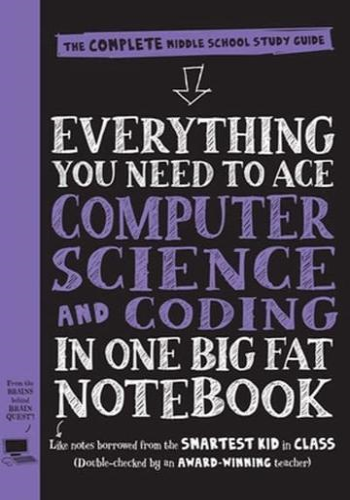Chapter 1: What is Computer Science
Everything You Need to Ace Computer Science and Coding in One Big Fat Notebook starts out by introducing the basics of Computer Science and Coding. First, it defines computer science as the study of how computers work and how they are used to solve a variety of problems. It gives examples of computer science principles, such as algorithms, binary data, binary numbers, software development, and data structures. The book then explains the various types of programming languages—low-level, high-level, and scripting languages—and describes how they are used to create computer programs and applications. As an example, the book gives an overview of the popular programming language - Python - and offers a brief tutorial on writing a basic program with the language to introduce readers to the basic concepts of computer science and coding.
Chapter 2: Logic and Algorithms
Chapter two of Everything You Need to Ace Computer Science and Coding in One Big Fat Notebook goes more in depth with the logic and algorithms used in programming. The book introduces logical operators, which are used to combine two or more conditions into one. It also describes how algorithms are used to solve complex problems, with an example of how the algorithm "Quick Sort" is used to sort a list of numbers from smallest to largest. The book uses diagrams to illustrate the concept of an algorithm step-by-step and goes further to explain the concept of control flow, which controls how code is executed and determines the order of instructions within an algorithm. The book writes algorithms in the Python language to demonstrate the writing process.
Chapter 3: Programming Basics
In Chapter three, Everything You Need to Ace Computer Science and Coding in One Big Fat Notebook introduces the basics of programming and software development. The book talks about data types, variables, and assignment statements, and how they are used in programming. It also introduces topics like error detection and debugging, and explains how to use debugging techniques to identify and correct errors in a program. The book provides an example of a program that uses the Python programming language to count the number of times a particular letter appears in a given phrase. As it steps through each line of code, the book explains the merge syntax and shows how the program works.
Chapter 4: Lists and Strings
Chapter four digs a little deeper into programming and covers the topic of lists and strings, two of the most essential data structures in computer science. Everything You Need to Ace Computer Science and Coding in One Big Fat Notebook explains how to declare a list, which is a collection of values and objects, and how to work with its elements. It introduces useful built-in functions and methods like len(), index(), and append() and shows how to use them to manipulate list elements.
The book also explains how to create strings in Python, an important data type for storing text data. It introduces techniques like concatenation, slicing, and string formatting as ways to manipulate strings, and teaches readers how to use regular expressions, a powerful pattern-matching tool, to search strings for patterns. As an example, the book shows readers how to use regular expressions to search a string for phone numbers.
Chapter 5: Conditional Statements and Loops
The fifth chapter of Everything You Need to Ace Computer Science and Coding in One Big Fat Notebook covers the topics of conditional statements and loops. It explains how to use if and if-else statements to execute code depending on certain conditions and then introduces for and while loops, which are used to repeat a set of instructions multiple times. It also goes over the concept of nested loops, which are used to multiple layer loops and loop through complex data structures. As an example, the book walks readers through a program that calculates the sum of each row and column in a two-dimensional list using a nested loop.
Overall, Everything You Need to Ace Computer Science and Coding in One Big Fat Notebook is an excellent talk-through of the basics of computer science and coding. The book starts out by introducing the fundamental concepts of computer science and coding and gradually moves on to cover more advanced topics like data structures, algorithms, and programming concepts. It provides a comprehensive look at all the major topics, with plenty of examples to illustrate how each concept can be used. This book is perfect for computer science and coding beginners and experienced coders alike.







